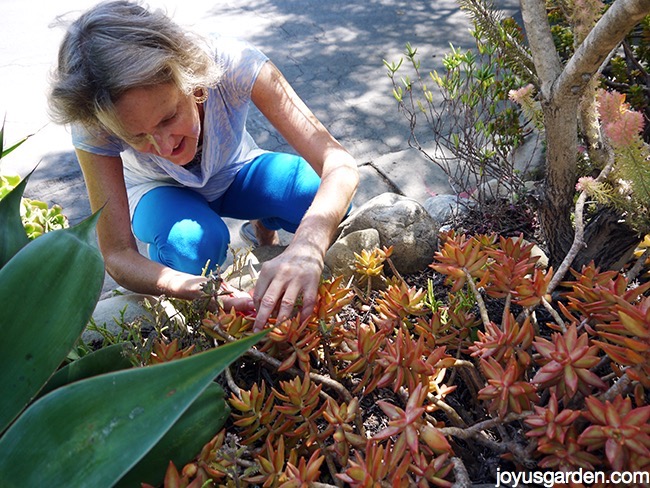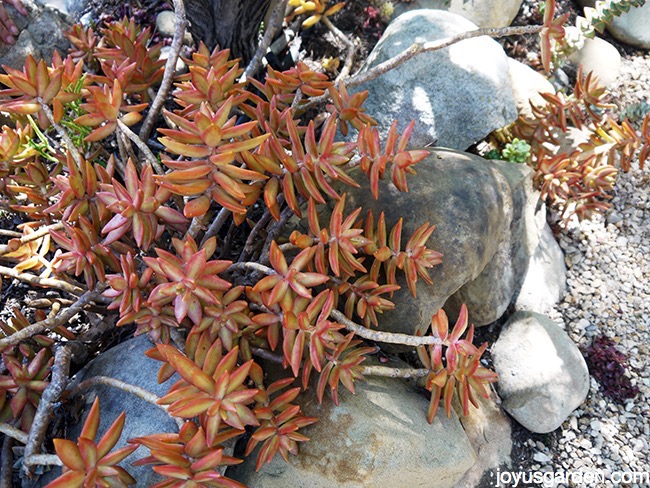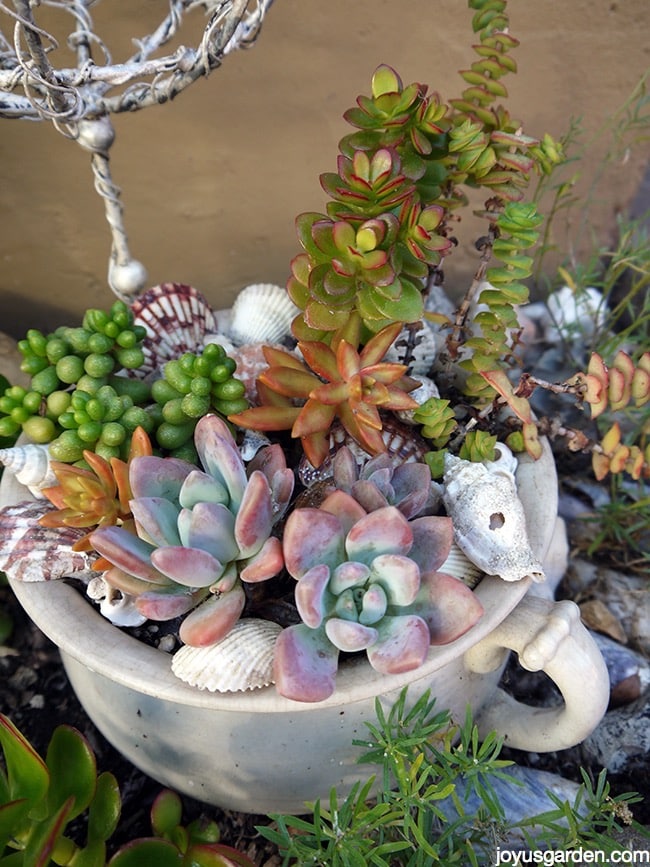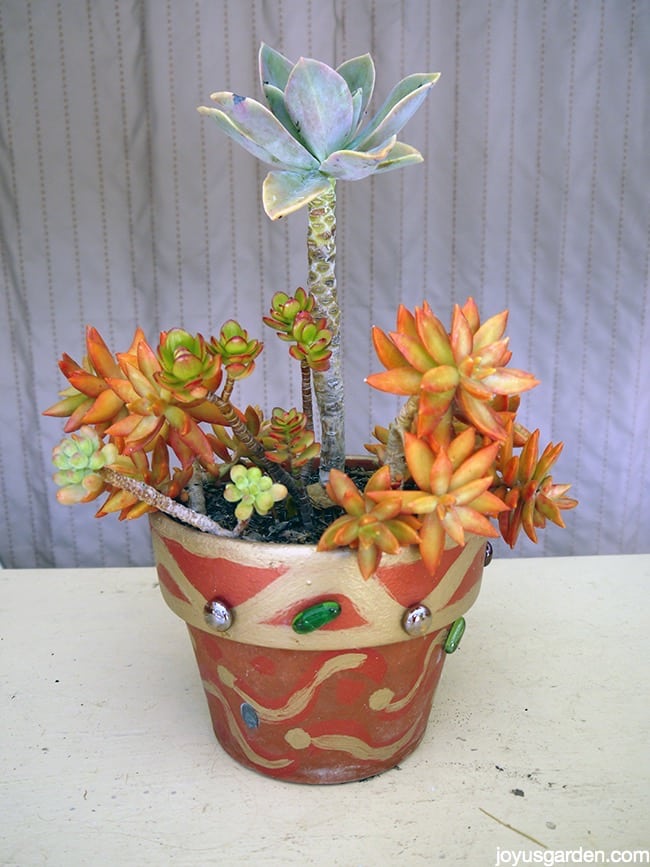用 Sedum Nussbaumerianum 为您的多肉植物花园增添一些橙味


花园里的橙色狂热!我喜欢 Coppertone Stonecrop &;我要分享我所知道的关于这种多肉植物的一切。
我非常喜欢花园里的橙色,所以当我在圣巴巴拉的一家苗圃里第一次看到 Sedum nussbaumerianum(俗称铜钱石)时,我立刻就对这种植物产生了欲望。 我应该为我新种植的多肉植物花园买 25 株还是 1 株就够了? 我选择了 1 株,并将这种引人注目的植物扦插到我花园的其他地方,而且还我深信,只要有可能,我就会把植物的好因缘传递下去,因为它最终会得到圆满的结果。

哦,那一抹橙色,真是我花园的点睛之笔。
说到扦插,我还将这种植物用于我的各种活体工艺项目,因为它的叶片非常厚实,能很好地脱离土壤。 有些多肉植物会有点干瘪,但这种植物不会。 它呈莲座状生长,叶片末端略微向上翻起,非常吸引人,也很有趣。

它的生长习性有些游荡,生长过程中会变得腿脚不便,因此是繁殖的最佳选择。 剪得越多,新长出的橘红色叶片就越多。 我称它为花园里的橘子酱!
这段视频告诉你我为什么喜欢这种生机勃勃的多肉植物:
以下是我种植 Sedum nussbaumerianum 或 Coppertone Stonecrop(顺便说一下,我叫它 Coppertone Sedum)的心得体会:
尺寸 这种多肉植物的生长习性非常松散,没有结构。
曝光: Coppertone Stonecrop 需要全日照或半日照,要避免烈日或反射阳光,因为叶片会被灼伤。 在加利福尼亚沿岸,它生长得很好,能忍受海风的吹拂。
See_also: Peperomia Obtusifolia:如何种植小橡胶树叶色 这一点与曝光度密切相关,但我想把它单独列出来,因为这是它的一大亮点。 在阳光充足的环境中,新长出来的叶片颜色是最浓烈的橙色。 树下的植株更像是暗淡的深蓝色;在较荫蔽的环境中生长时,整株植物都会呈现出这种颜色。

左边的两株扦插植物生长在阳光充足的地方,而另一株扦插植物则生长在半阴的地方。
水 这种植物的浇水需求很低。 我的花园使用滴灌系统,在温暖的月份,每隔 8-10 天浇水 15 分钟。 我的多肉容器常年生长在室外,每隔 7-12 天浇水一次。 浇水的频率取决于花盆的大小、花盆的类型以及温度的高低。
土壤 良好的排水系统至关重要。 我在花园里添加了疏松的表土,以确保水分彻底排出。 如果种植在容器中,最好使用多肉植物和仙人掌的混合种植土。
肥料: 我不使用任何肥料,但每年春天都会用蚯蚓粪给我的容器植物施肥。 在花园里,我每 2-3 年施用一次大容量堆肥。 如果您觉得有必要给这种景天科植物施肥,春季施用一次均衡的液体家庭植物肥料就足够了。
温度 Sedum nussbaumerianum 的耐寒能力为华氏 28-30 度。
传播: 很简单,我经常这样做!茎插和叶插繁殖都很容易,不过叶插需要更长的生长时间。 我做过一篇关于繁殖多肉植物的文章和视频,里面有详细的指导。
鲜花 从冬季到早春,会开出星星点点的白色小花。 凑近闻一闻,会有淡淡的清香。
用途 这种景天科植物与我花园里各种深浅不一的绿色多肉植物形成了鲜明的对比,也与我的酒红色白头翁形成了鲜明的对比。 它适合岩石花园和容器,甚至吊篮。 我还用它来完成我的多肉植物手工项目。

这个容器生长在明亮的树荫下。 铜色石莲花的橙色和铜色要少得多,但却很紧凑。

而且,扦插苗已经开始从花盆中溢出。

如果您有石墙或高架种植,那么这种生机勃勃的景天科植物会像冠军一样从缝隙中脱颖而出。
我很喜欢这种铜色石竹--你能看出来吗!我一直在繁殖它,把它种到花园里其他我认为需要点缀的地方,等我搬离这栋房子时,我一定会扦插一两株。 橙色花园并不适合所有人,但对我来说,它是通往园艺天堂的一条快速直达之路!
快乐园艺
你也喜欢用多肉植物制作手工艺品吗? 我用铜色景天科植物制作了这些作品:
多肉植物框架
See_also: 来参观一下我的容器植物吧,圣诞快乐!棕榈碎片上的多肉植物壁画
用漂流木、多肉植物和空气植物制作一件简单的墙面艺术品
您可能还会喜欢
7 种令人喜爱的悬挂式多肉植物
多肉植物需要多少阳光?
应该多久给多肉植物浇一次水?
多肉植物和仙人掌花盆用混合土
如何将多肉植物移栽到花盆中
芦荟 101:芦荟植物护理指南综述
本文章可能包含联盟链接。 您可以在此阅读我们的政策。 您购买产品的成本不会增加,但 Joy Us garden 会收取少量佣金。 感谢您帮助我们传播信息 & 让世界变得更美丽!

